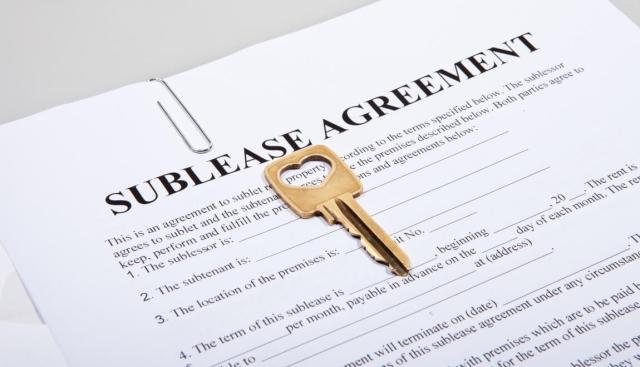
When a tenant breaks their lease early, it’s easy to feel panicked and overwhelmed. However, there are several solutions for when your renter prematurely leaves, including the sometimes risky yet rewarding option of subleasing.
Subleasing your rental property lets you maintain your rental income when a tenant leaves mid-lease. Though seemingly a no-brainer solution, subleasing comes with risks that may raise the question: Is subleasing my property a good idea? To help you decide, here’s our guide on the pros and cons of subleasing, which will cover the following:
- Sublease definition and how it works
- Pros and cons of subleasing your rental property
- Legal considerations for landlords who sublease
- Best practices for managing a sublease
How Does Subleasing Work?
A sublease is an agreement between an existing tenant and a new third party where the third party, known as the subtenant, agrees to fulfill the remainder of the tenant’s existing lease contract. This often occurs when an existing tenant moves out unexpectedly for reasons like finding a new job or getting married. Finding a subtenant allows the renter to vacate the property without breaking their lease or facing financial repercussions.
A tenant’s right to sublease depends on their lease agreement and local and state laws. Most lease agreements will include a subleasing clause that explains what is permitted and not permitted. For example, some landlords might allow subleasing as long as they’re appropriately notified, while others may prohibit it completely.
Depending on where you live, you may be subject to state laws that take precedence over your lease agreement. Take San Francisco, for example, where tenants can replace a roommate with a subtenant, even if their lease agreement says otherwise, as long as the replacement meets screening standards. Another good example is New York City. Here, a tenant who lives in a building with four or more units has the right to sublease as long as the landlord consents. Make sure to check your state laws before creating a sublease clause, as there’s always a chance your stance could be overridden by public policy.
How subleasing differs from standard lease agreements
A sublease differs from a standard lease agreement in many ways. Firstly, a sublease fosters a different landlord-tenant dynamic. Unlike a traditional lease between a landlord and tenant, a sublease involves three parties: the landlord, the original tenant, and the subtenant.
With a sublease, the original tenant remains responsible for abiding by their lease agreement and paying monthly rent, even if they’re not occupying the unit. The subtenant, in turn, pays rent to the original tenant, who then gives the money to the landlord. This triangular dynamic can be complicated and lead to miscommunications, especially because the landlord has limited interaction with the subtenant.
Another key difference between a sublease and a traditional lease is tenant liability. Regardless of whether they occupy the property, the original tenant is always responsible for adhering to the lease. That means if a subtenant misses a rent payment, damages the property, or violates the lease in any regard, the original tenant will be at fault. That is, of course, if the landlord doesn’t have a separate legal agreement with the subtenant, known as subletting.
Subletting vs. subleasing
Though often used synonymously, subletting and subleasing are two different concepts. Subleasing creates that triangular dynamic mentioned above, where a subtenant communicates with a landlord through the original tenant. Subletting, on the other hand, creates a direct line of communication between a subtenant and a landlord.
Subletting a rental property means creating a new contract involving only the subtenant and the landlord. This contract will allow the subtenant to pay rent directly rather than through the original tenant. Typically, subletting completely severs ties with the original tenant, shifting all responsibility to the subtenant. This option minimizes miscommunication and liability disputes. However, it may not always be allowed or feasible, depending on your existing lease agreement and state laws.
The Pros and Cons of Allowing Your Tenants to Sublease
Now that we’ve covered some of the basics, let’s explore the pros and cons of subleasing your rental property. Before you decide whether to allow subleasing, consider each of the following:
Pro: Subleasing minimizes vacancy
One of the biggest upsides to subleasing is that it minimizes property vacancy periods. When a tenant unexpectedly breaks their lease, your property becomes vacant and unprofitable until a new tenant moves in. Subleasing allows you to fill your unit immediately after your tenant moves out, allowing you to maintain your rental income through the rest of the lease term. This is particularly beneficial in competitive rental markets where finding a new tenant can be difficult.
Con: You may not get to choose the new subtenant
Subleasing your rental sometimes means giving up control over who takes over the lease. A lot of times, existing tenants will already have a subtenant in mind. However, there’s always a chance that the candidate doesn’t meet your standards. This is why enforcing clear subleasing guidelines in your lease agreement is important. If state laws allow, you should require a secondary screening process for subtenants to ensure they’re well-fit. Otherwise, you risk putting your property in the wrong hands until the next lease term.
Pro: Subleasing appeals to a wider pool of renters
Subleasing can broaden your pool of potential tenants. Whether it be students, short-term workers, or those in transitional life periods, subleasing provides options for renters seeking flexible, short-term living arrangements. Rather than limiting your pool strictly to those looking for long-term leases, consider how subleasing could widen your options and attract renters of all different lifestyles and circumstances.
Con: You could experience legal complications
One of the biggest downsides to subleasing is the risk of legal complications. As mentioned earlier, subleasing a property can create confusion and miscommunication between you, your original tenant, and your subtenant. As a result, you might run into liability disputes over unpaid rent, property damage, and other issues that could evolve into legal problems. To avoid complications, explicitly outline sublease expectations in your lease agreement and ensure they align with local rental laws.
Pro: Subleasing can be financially beneficial for landlords and tenants
If all goes well, subleasing could be the answer to all of your and your tenant’s financial worries. For you, it means maintaining your revenue stream and avoiding tenant turnover costs. For your tenant, it means not having to pay rent for a unit they no longer inhabit. This arrangement mitigates financial stress on both fronts and can make for a win-win situation.
Con: You may face increased wear and tear
More tenants coming in and out of your property can mean more property wear and tear. With a rotating door of renters, appliance usage and the likelihood of damage increases. This is especially true if you’re unable to vet subtenants like you would for initial rental applicants. To avoid excessive damage, include clear expectations for maintaining the property and consequences for any damage in your subleasing guidelines.
Pro: A subtenant could sign a full-term lease later on
In some ways, subleasing allows for a trial period with your subtenant. During their tenancy, you can evaluate their reliability and suitability for a long-term lease. Then, once the original lease term ends, you can propose that they sign a new, full-term lease. This arrangement eliminates the need to find a new tenant and allows for a smooth transition for both parties. Not to mention, it can also plant the seeds for a long-term, positive landlord-tenant relationship.
Con: You may face potential conflicts with neighbors and the community
A subtenant may cause community conflicts if unaware of neighborhood dynamics and guidelines. However, if this happens, community members may fault you rather than the subtenant themself. To preserve your reputation and minimize the risk of disruptions, include community guidelines in your sublease clause. You may mention how subtenants must abide by quiet hours, parking regulations, and other neighborhood rules.
Legal Considerations for Landlords
Earlier, we touched on tenant and landlord rights regarding subleasing. Understanding the legal intricacies of subleasing a rental property is crucial, as even the smallest misstep could violate tenant rights and lead to potential legal disputes.
Before choosing your stance on subleasing, check your state and local laws to determine your rights and restrictions. Some states, like New York City or San Francisco, have mandates that limit your ability to deny subleasing requests. Knowing local laws will help you make informed decisions when writing your lease agreement, especially when outlining subleasing parameters.
If your state laws permit, your next step is to create a sublease clause for your lease agreement. This section should outline your expectations for subleasing, from included fees to rent payment protocols. If you’re not sure where to start, check out this example below:
Tenants are prohibited from assigning or subletting any portion of the leased premises without the landlord's prior written consent. Additionally, only the named tenants are permitted to occupy the property. Subleasing does not absolve any tenant or co-signer from their responsibilities under the Lease Agreement, including the obligation to pay rent. A one-time fee of $100 applies for each subtenant applying to be added to the Lease Agreement.
With Apartments.com, you can seamlessly create a lease that aligns with both your and your state’s guidelines. Our platform provides state-specific leasing templates for all 50 states so landlords can feel confident in their lease agreements. Plus, our lease templates are fully customizable so that you can tailor them exactly to your liking.
Best Practices for Managing Subleases
Choosing your stance and creating a lease that reflects it is only half the battle. Once you’ve enforced subleasing guidelines through your lease agreement, you must ensure you’re prepared for sublease management. Here are a few best practices to keep in mind:
Clear communication with tenants
Clear communication is key when it comes to subleasing your rental property. Before a tenant moves in, make sure they’re aware of your subleasing policies. Establish a direct line of communication early on in case they have any questions about subleasing down the line.
Property inspections and oversight
Conducting regular property inspections helps you monitor your rental’s condition. This is especially important if you’re leasing to a subtenant who may not be legally liable for property damage. Schedule rental inspections quarterly or bi-annually to keep a pulse on maintenance needs and property care during subleasing periods.
Thorough tenant screening
If state laws permit, enforcing a secondary tenant screening process for subtenants can mitigate potential risks. Vetting them through pre-screening interviews and background checks will confirm whether they’re a good fit for your property. Consider the same criteria you would for initial renters (financial stability, rental history, etc.) to ensure you’re bringing in a responsible occupant.
Master Property Management with Apartments.com
Managing a rental property can be challenging, especially when dealing with subleasing. While it can benefit your rental business, subleasing can pose many risks for landlords. Understanding the pros and cons of subleasing allows you to make informed decisions about your property management strategies and protect your investment.
Apartments.com simplifies property management with our expansive suite of Rental Tools. From generating rental leases to screening tenants, our platform is your one-stop shop for stress-free property management. Start optimizing your rental business today with Apartments.com!
FAQ
Can a tenant sublease without their landlord’s consent?
In most cases, tenants cannot sublease without their landlord’s consent, as it’s typically prohibited in the lease agreement. Landlords have the right to approve or deny subleasing to ensure the new tenant meets their standards.
What are the negatives of allowing subleasing?
Allowing subleasing can lead to issues with accountability, as the subtenant is not directly bound to the original lease. Landlords may face challenges with property care, payment reliability, or potential legal disputes if problems arise.
What are the positives of allowing subleasing?
Subleasing can help tenants avoid breaking their lease if they need to move unexpectedly, preventing financial loss. For landlords, it ensures the property remains occupied, and rent continues to be paid, reducing vacancies.











